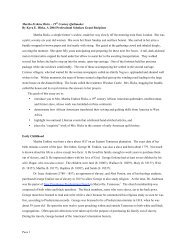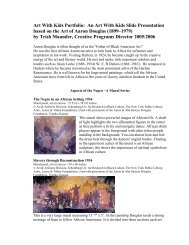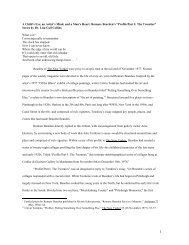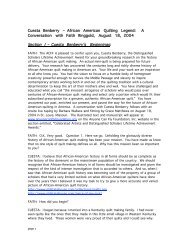Casting Feral Benga - The Anyone Can Fly Foundation, Inc.
Casting Feral Benga - The Anyone Can Fly Foundation, Inc.
Casting Feral Benga - The Anyone Can Fly Foundation, Inc.
You also want an ePaper? Increase the reach of your titles
YUMPU automatically turns print PDFs into web optimized ePapers that Google loves.
What appear as minor differences between the two<strong>Feral</strong> <strong>Benga</strong> editions of , separated by more than fifty years,actually alter the figure’s rhythm and visual impact. <strong>The</strong> editioncast in 1986 represents an artist distanced by advanced age anddisengagement with the subject. Details that would have ensuredfidelity to the earlier casts went unchecked and are perhaps a signthat the later edition was market driven rather than guided byartistic concerns. For example, the palm of <strong>Feral</strong> <strong>Benga</strong>’s hand inthe 1986 edition completely envelops the machete handle.Without the handle’s butt making the instrument distinct from thefigure’s hand, the blade flows like a licentious extension. <strong>The</strong>base, thicker and smaller, is a platform that no longer reminds usof the spotlights that illuminated <strong>Benga</strong> and captured Barthé’simagination. Both machete and base, cast separately and thenwelded to the finished bronze figure became mere plastic props.But, the most overwhelming difference between the two is thesurface finish. 24<strong>The</strong> exterior of the 1986 edition lacks the signature tracesof the sculptor’s hands. <strong>The</strong>se track marks Barthé left imbedded his working life into thesurface, the time he spent creating the work, into his art. <strong>The</strong> overall shimmer created by lighton the 1935 <strong>Feral</strong> <strong>Benga</strong> clings like perspiration on a exhausted dancer’s body. It remainsunknown how involved the octogenarian Barthé was with the 1986 casting of <strong>Feral</strong> <strong>Benga</strong>. 25More in line with his work from the 1960s and after, but in stark contrast with the 1935 <strong>Feral</strong><strong>Benga</strong>, the slick surface on the later model robs the figure of its powerful tactile qualities anddeadens its once erotic impact – an echo of the original.<strong>The</strong> lost casts of the exquisite <strong>Feral</strong> <strong>Benga</strong> will no doubt find their way to center stage asRichmond Barthé’s art receives long-overdue celebration. <strong>Feral</strong> <strong>Benga</strong>, a portrayal of a modernAfrican ‘acting savage,’ is much more than choreographed or contrived ethnicity. It is a keywork in Barthé’s autobiography, the era’s history, and a forgotten dancer’s memory. <strong>Feral</strong><strong>Benga</strong> is 20 th century American sculpture at its provocative best.






